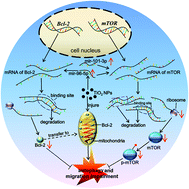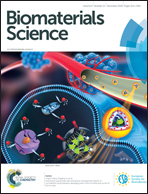miR-96-5p and miR-101-3p as potential intervention targets to rescue TiO2 NP-induced autophagy and migration impairment of human trophoblastic cells†
Abstract
Autophagy induced by titanium dioxide nanoparticles (TiO2 NPs) has been realized nowadays, but the underlying mechanisms remain largely unknown. Animal studies have confirmed that autophagy might be an important mechanism to impair placenta development, but the reversal of damage is not clear. Here, we used human HTR-8/SVneo (HTR) cells as a proper model to explore how autophagy is regulated in TiO2 NP-exposed human placenta cells. Our studies showed that TiO2 NPs could enter HTR cells and locate in cytoplasm. Although they did not affect cell viability even under 100 μg ml−1, autophagy was observed and cell migration ability was severely impaired. Further study showed that TiO2 NPs increased the expressions of both miR-96-5p and miR-101-3p and then, they targeted mTOR and decreased the expression of mTOR proteins. In addition, miR-96-5p also targeted Bcl-2 to down-regulate Bcl-2 protein level, which is also a key regulator of autophagy. We proved that when two microRNA inhibitors were added, cell autophagy was, to a greater extent, reversed compared with the result when one inhibitor was added, and the cell migration ability was also reversed to a greater degree. Our studies revealed that TiO2 NPs might impair placenta development via autophagy. Moreover, miR-96-5p as well as miR-101-3p may act as potential targets to reverse TiO2 NP-induced autophagy and placenta dysfunction.



 Please wait while we load your content...
Please wait while we load your content...